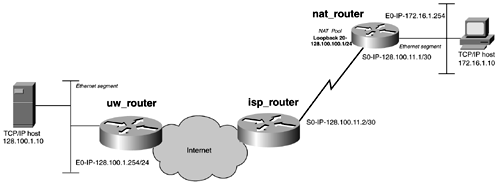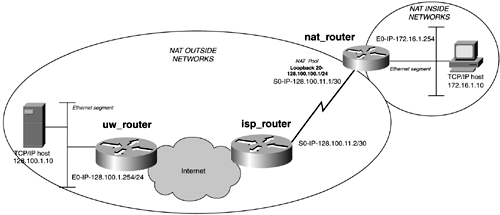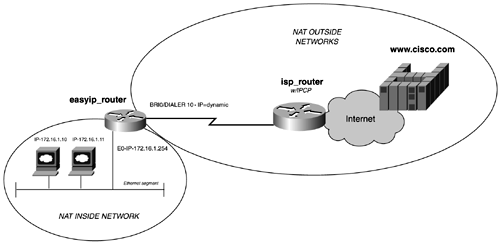Lab 32: Configuring Static NAT and DSLw-Part II
| < Free Open Study > |
Configuring NATNAT translation can be configured in three primary ways:
All three methods of configuration follow a similar four-step process:
Configuring NAT Dynamic TranslationUsing the four-step process listed, now you will walk through the NAT configuration that you did earlier in this chapter. Figure 15-2 illustrates a private IP network of 172.16.1.0/24. Figure 15-2. Dynamic NAT Example This network needs reachability to the Internet ” specifically , the host 128.100.1.10 on the UW Ethernet segment. The router nat_router has a T1 connection to the Internet through the isp_router. The ISP has assigned the network 128.100.100.0/24 to nat_router for access to the Internet. The engineers who support nat_router do not want to change all the IP host addresses from a 172.16.1.x network to a 128.100.100.x network, so they use dynamic NAT. First, you must define NAT inside and outside networks. The inside network is where the networks to be translated reside, while the outside network is your destination network. In this example, your E0 port will become your NAT inside interface, while your S0 port will be your NAT outside interface. Figure 15-3 highlights the inside and outside networks. Figure 15-3. NAT Inside and Outside Networks To configure the inside and outside interface, use the ip nat [ inside outside ] command. Example 15-3 demonstrates the use of the command. Example 15-3 Configuring Inside and Outside Interfacesnat_router(config)# interface e0 nat_router(config-if)# ip nat inside nat_router(config-if)# exit nat_router(config)# interface s0 nat_router(config-if)# ip nat outside The next step requires you to "anchor" the subnet that you are translating to on this router. You do this by assigning the network given to you from your ISP ”in this case, 128.100.100.0/24 to a local interface. Use the first host address on the loopback interface, and use 128.100.100.2 to 128.100.100.254 as the address pool. The second part of this step requires that you have a route to the outside network and that the outside networks have a route to the subnet 128.100.100.0/24. For this example, you add a static default route on the nat_router and you use the ip classless command, which would appear as follows : interface Loopback20 ip address 128.100.100.1 255.255.255.0 ip classless ip route 0.0.0.0 0.0.0.0 128.100.11.2 Relevant to this example but not shown is a static route on the isp_router to the subnet 128.100.100.0/24. This route must be propagated by the isp_router to any and all destination networks, such as the uw_router. At this point, before proceeding, ensure that all routers have IP reachability to the 128.100.100.0/24 subnet. Without IP reachability, NAT will fail. The third step in the process is to use the ip nat inside source command to define the networks to be translated. In this example, you will use the following commands: ip nat inside source list 69 pool publicpool access-list 69 permit 172.16.1.0 0.0.0.255 This command sequence calls access list 69 and compares the source network of the packet coming in the inside interface to the list. If the source IP address is in the subnet range of 172.16.1.x, the network is translated to the IP pool called publicpool. Finally, the last step is defining the pool publicpool using the ip nat pool command: ip nat pool publicpool 128.100.100.2 128.100.100.254 netmask 255.255.255.0 This statement uses the IP address range of 128.100.100.2 to 128.100.100.254, with a subnet mask of 255.255.255.0 for translation. Because 128.100.100.1 is the address of the loopback address, you do not want to include it in the pool range. Example 15-4 lists the relevant portions the configuration of the nat_router. Example 15-4 NAT Dynamic Translation Configurationhostname nat_router ! ! ip subnet-zero ! interface Loopback20 ip address 128.100.100.1 255.255.255.0 no ip directed-broadcast ! interface Ethernet0 ip address 172.16.1.254 255.255.255.0 no ip directed-broadcast ip nat inside ! interface Serial0 ip address 128.100.11.1 255.255.255.252 no ip directed-broadcast ip nat outside ! <<<text omitted>>> ! ip nat pool publicpool 128.100.100.2 128.100.100.254 netmask 255.255.255.0 ip nat inside source list 69 pool publicpool ip classless ip route 0.0.0.0 0.0.0.0 128.100.11.2 ! access-list 69 permit 172.16.1.0 0.0.0.255 Configuring NAT Static TranslationConfiguring static translation is similar to configuring dynamic translation, except that you do not configure an IP pool. Instead, you configure a one-to-one address map of which specific hosts are to be translated to a specific address. A static translation can be used as an inside static translation or can have an outside static translation. Most implementations of NAT simply use an inside static translation, but when NAT is overlapping, you might want to use an outside source translation. Building on the previous example of NAT illustrated in Figure 15-3, modify it so that only one address, 172.16.1.10, will be translated to 128.100.100.10. To configure static NAT, follow the same steps as previously defined, which include defining the inside and outside networks. Define the loopback address to "anchor" the global network and ensure routing between this subnet, 128.100.100.0/24, and the outside networks. The only part that is different from dynamic NAT configuration is defining how networks get translated. Instead of using the ip nat inside source list x command, use the ip nat inside static command. Specifically, this example uses the following command: ip nat inside source static 172.16.1.10 128.100.100.10 This command causes the address 172.16.1.10 to be mapped to 128.100.100.10. No other translations will occur on the router. Example 15-5 lists how the configuration would appear with a static configuration. Example 15-5 NAT Static Translation Examplehostname nat_router ! ip subnet-zero ! interface Loopback20 ip address 128.100.100.1 255.255.255.0 no ip directed-broadcast ! interface Ethernet0 ip address 172.16.1.254 255.255.255.0 no ip directed-broadcast ip nat inside ! interface Serial0 ip address 128.100.11.1 255.255.255.252 no ip directed-broadcast ip nat outside ! <<<text omitted>>> ! ip nat inside source static 172.16.1.10 128.100.100.10 ip classless ip route 0.0.0.0 0.0.0.0 128.100.11.2 Configuring Easy IP and Port Address Translation (PAT)Perhaps "Easy IP" expresses the best example of overloading a single IP address for NAT. Easy IP combines NAT overload/PAT and PPP/Internet Protocol Control Protocol (IPCP). However, NAT TCP overload is not limited to PPP. For the purposes of this text, TCP overload and PAT are synonymous. PAT provides for many-to-one IP translations. Essentially, this allows many IP addresses to share or be translated into a single IP address. PAT uses a unique source port number on the inside global IP address to distinguish between each translation. Easy IP (Phase 1) enables a Cisco router to automatically negotiate its own registered WAN address, and it enables local hosts to access the global networks or Internet through this single IP address. Many ISPs use IPCP to dynamically assign an IP address to the remote serial interface. Because this address is unknown until it is assigned, NAT static and dynamic translations cannot be configured. Therefore, to accommodate this type of configuration, Cisco uses Easy IP. Essentially, this is what happens:
NOTE To configure Easy IP, you must have Cisco IOS Software Release 11.3 or later. To configure Easy IP, you can begin by following the four-step process outlined earlier. The main difference occurs in Step 4 and the enabling of IPCP. Figure 15-4 illustrates a typical home user or small office with an ISDN connection to an ISP. The home user does not have any registered IP address space and obtains an address when dialing up the ISP. This user also has multiple workstations that must access the Internet, providing an ideal candidate for Easy IP. Figure 15-4. Easy IP Example The first step is to define inside and outside networks. Here, the inside network is the Ethernet, while the BRI or Dialer 10 interface is the outside network. Use the same NAT commands, ip nat inside and ip nat outside, to define these networks on the appropriate interfaces. The next step is to ensure that routing exists between the router and the Internet. Because only one exit point exists, use a default static route pointing to the dialer interface. Be sure to include the ip classless command when using a default route. The third step involves defining what networks are to be translated and how they are translated. Here, you will point your translation to the Dialer 10 interface because the IP address is unknown. Use the overload command, which tells the router to use PAT. Doing so enables many connections to the Internet through one IP address. The command will look like the following: ip nat inside source list 10 interface Dialer10 overload Because you don't have an address pool to define static translations, Step 4 is a good place to configure IPCP. To configure IPCP, you must have PPP as your Layer 2 encapsulation, and you must have Cisco IOS Software Release 11.3 or greater. The command to enable IPCP is ip address negotiated under the serial or dialer interface. Example 15-6 illustrates the dialer configuration and IPCP needed on the easyip_router. Example 15-6 IPCP and Dialer Configuration for Easy IPinterface BRI0 no ip address no ip directed-broadcast encapsulation ppp dialer pool-member 10 isdn switch-type basic-ni isdn spid1 71538154750101 3815475 isdn spid2 71538154760101 3815476 ppp multilink ! interface Dialer10 ip address negotiated Notice that most ISPs also use PAP for authentication. This also might be a requirement for your configuration to the ISP. For more information on the dialer configurations or ISDN setup, see Chapter 7, "WAN Protocols and Technologies: Integrated Services Digital Network (ISDN)." Example 15-7 lists the entire configuration needed for Easy IP. Example 15-7 Easy IP Configurationhostname easyip_router ! ip subnet-zero ! isdn switch-type basic-ni ! interface Ethernet0 ip address 172.16.1.254 255.255.255.0 no ip directed-broadcast ip nat inside ! interface BRI0 no ip address no ip directed-broadcast encapsulation ppp dialer pool-member 10 isdn switch-type basic-ni isdn spid1 71538154750101 3815475 isdn spid2 71538154760101 3815476 ppp multilink ! interface Dialer10 ip address negotiated no ip directed-broadcast ip nat outside encapsulation ppp no ip mroute-cache dialer remote-name isp_router dialer idle-timeout 300 dialer string 4262200 dialer hold-queue 80 dialer load-threshold 10 either dialer pool 10 dialer-group 10 no cdp enable ppp authentication pap ppp pap sent-username ksolie password 7 1304474B5B5D577E ppp multilink ! ip nat inside source list 10 interface Dialer10 overload ip classless ip route 0.0.0.0 0.0.0.0 Dialer10 ! access-list 10 permit 172.16.1.0 0.0.0.255 access-list 110 permit ip any any dialer-list 10 protocol ip list 110 |
| < Free Open Study > |
EAN: 2147483647
Pages: 283


